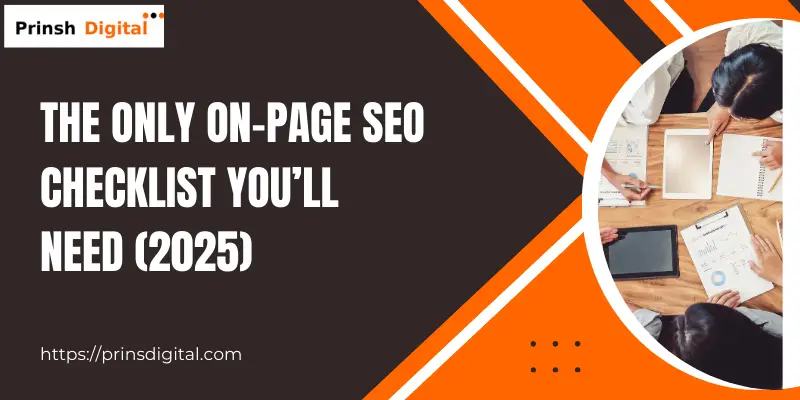Introduction: Why On-Page SEO Still Matters in 2025
In an era dominated by AI-generated content, zero-click search results, and shifting Google algorithms, you might wonder — does on-page SEO still matter?
Short answer: More than ever.
With the rise of AI, Google’s emphasis on quality, context, and user experience has never been higher. That’s why we created the only on-page SEO checklist you’ll ever need for 2025 — backed by data, tested on real websites, and designed to be easily automated with AI tools.
Whether you’re a solo blogger or managing a digital agency, this guide from Prins Digital will walk you through every element that matters and show you how to automate tasks with AI to save time and scale your rankings.
1. What Is On-Page SEO (And Why It’s Changing)?
On-page SEO is the practice of optimizing individual web pages to rank higher in search engines. It includes everything from your content to your meta tags, internal links, and site speed.
But here’s what’s different in 2025:
- Google now evaluates E-E-A-T: Experience, Expertise, Authoritativeness, and Trustworthiness.
- AI is everywhere, and search engines are prioritizing original, helpful, human-first content.
- User signals (UX metrics) like bounce rate, time on page, and scroll depth have become indirect ranking factors.
Bottom line: Your on-page SEO checklist needs to go beyond just keywords — and include design, speed, and AI readiness.
2. The 2025 On-Page SEO Checklist: Overview
Here’s what your SEO-friendly page needs in 2025:
✅ SEO Title Tag
✅ Meta Description
✅ URL Structure
✅ Header Tags (H1, H2, H3…)
✅ Keyword Placement (Natural)
✅ Internal & External Links
✅ Image Optimization (Alt + Compression)
✅ Schema Markup
✅ Mobile-First Design
✅ Core Web Vitals
✅ Topical Relevance
✅ AI Content Transparency (Disclosures + Voice)
✅ Author Bio or Source Credibility
✅ Accessibility Tags (ARIA, Contrast, Readability)
✅ Social Sharing Elements
✅ AI-Assisted Audit Tools
Let’s dive deeper into each element and show you how to automate many of these tasks with AI.
3. Technical SEO Foundations (Still On-Page!)
These aren’t the flashiest parts of SEO, but they’re the foundation.
✅ Title Tag (Under 60 Characters)
- Include the primary keyword (e.g., on-page SEO checklist).
- Place the keyword near the beginning.
- Make it clickable: add numbers, brackets, or power words.
💡 AI Tip: Use tools like Jasper or ChatGPT to generate multiple title options in seconds.
✅ Meta Description (Under 160 Characters)
- Summarize the benefit of your post.
- Include your target keyword naturally.
💡 AI Tip: Automate with RankMath AI, Yoast, or Surfer SEO to generate and score your meta descriptions.
✅ Clean URL Structure
- Keep it short and relevant (e.g., /on-page-seo-checklist-2025)
- No random strings or dates.
✅ H1 + Header Hierarchy
- One H1 only (main topic).
- Use H2s and H3s to break down content logically.
💡 AI Tip: ChatGPT + Surfer SEO combo can build your blog post outline using keyword clusters automatically.
✅ Mobile-First and Speed Optimized
- Use responsive themes.
- Compress images, defer JavaScript, and lazy-load below-the-fold content.
📈 Tool Recommendation: Google PageSpeed Insights + NitroPack for real-time site speed boosts.
4. Content Optimization: The Human + AI Formula
Content is still king — but in 2025, “helpful content” is king. Google’s algorithm rewards:
- Original insights
- Real experience
- Clear answers to search intent
- Structured formatting for readability
✅ Keyword Placement (Without Stuffing)
- Primary keyword in:
- H1
- First 100 words
- At least one H2
- Meta Description
- Image alt tag
- URL
- Use LSI keywords (related phrases like “SEO audit,” “optimize content,” “improve rankings”)
💡 AI Tip: Frase.io, NeuronWriter, and Surfer SEO analyze top-ranking pages and suggest real-time keyword usage.
✅ On-Page SEO Checklist – Internal + External Linking
- Link to 2–3 related blog posts.
- Link to authoritative external sources (Moz, Google, etc.)
- Use descriptive anchor text.
✅ On-Page SEO Checklist – Image Optimization
- Compress images with TinyPNG or ShortPixel
- Use descriptive alt tags (with keywords if relevant)
- Include image schema where possible
✅ Schema Markup (Structured Data) for on-page SEO
- Add Article schema, FAQ schema, or How-To schema
- Boosts chance of appearing in rich snippets.
💡 AI Tip: Use Schema Pro or Mermaid.js + GPT-4 to auto-generate structured schema code for your posts.
✅ On-Page SEO Checklist – Accessibility & UX
- Use proper heading structure.
- Check contrast ratios for readability.
- Include ARIA labels if using interactive elements.
📈 Tool Recommendation: axe DevTools, WAVE Accessibility Checker
Also, Read
5. AI Tools to Automate On-Page SEO Tasks
Let’s talk about saving time. You can automate 60–70% of your on-page SEO with these tools:
1. Surfer SEO
- Real-time content score
- Keyword suggestions
- SERP comparison
2. Frase.io
- Content briefs
- Outline generator
- AI writing assistant
3. ChatGPT + Web Browsing Plugin
- Generate FAQs, blog outlines, and SEO titles
- Summarize competitor content for benchmarking
4. RankMath Pro
- Auto-generate meta tags, schema, sitemaps
- Built-in AI scoring and optimization suggestions
5. Screaming Frog + GPT Combo
- Crawl your site and send data to ChatGPT for analysis on missing tags, duplicate content, etc.
Pro Tip from Prins Digital: Train GPT on your brand tone, typical post formats, and content clusters. Let it become your 24/7 SEO assistant.
6. Real-World Examples from Our Clients
We’ve implemented this checklist with dozens of businesses across industries — and here’s what happened:
🔍 Case Study 1: SaaS Startup Blog and Service Pages
- Problem: 50 blog posts, low traffic, poor optimization
- Solution: On-page SEO overhaul using our 2025 checklist
- AI Tools Used: Surfer SEO, ChatGPT
- Result: +215% traffic in 3 months
📚 Case Study 2: Individual Blogger
- Problem: Generic content, no schema, no proper use of graphics, and internal linking
- Solution: Rewrote content using Frase + added How-To schema + proper internal linking, and relevant images
- Result: Featured snippets on 4 high-volume keywords
🛍️ Case Study 3: E-Commerce Site
- Problem: No internal linking, long load time
- Solution: Implemented NitroPack, built internal link maps with ChatGPT
- Result: Improved bounce rate by 30%, CTR up 22%
7. Final Thoughts: SEO That Works in 2025
SEO isn’t about tricking Google. It’s about delivering the best experience and giving people exactly what they came for. When you combine human-first content with AI-backed optimization, you win.



